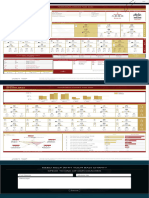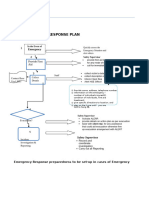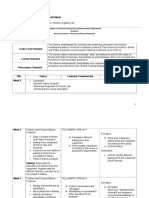Carry On
Carry On
Uploaded by
shafanabilahCopyright:
Available Formats
Carry On
Carry On
Uploaded by
shafanabilahOriginal Title
Copyright
Available Formats
Share this document
Did you find this document useful?
Is this content inappropriate?
Copyright:
Available Formats
Carry On
Carry On
Uploaded by
shafanabilahCopyright:
Available Formats
Carry on caring
How leadership development boosts NHS performance
opular theory has it that leaders are born, not made. While few would doubt that there is some substance to that claim, logic tells us that the ready packaged leader is the exception rather than the rule. For the majority of us, therefore, it is the way we develop our leaders that can enable them to stand out from the crowd.
Many are waking up to the fact that leadership is inextricably linked with organizational effectiveness. Develop the right leaders and the dream of long-term sustainability becomes ever more attainable. The opposite is, of course, also true. Like most other things, leadership is subject to change. Trends come and go and todays leadership style can quickly become tomorrows relic. Only those models with one eye on the future are able to stand the test of time.
The changing face of leadership development
There is growing belief that transformational leadership is one such model. Instead of a total focus on specic organization objectives that is typical of transactional leadership, this open-ended style places more emphasis on innovation and vision. Recognizing and developing the ability to lead is at least as important as achieving any number of dened outcomes. The UKs National Health Service (NHS) is an organization that realizes the benet of encouraging a more exible and less prescribed mode of leadership. One consequence of this has seen the emergence of a leadership development program aimed at human resource (HR) professionals and other NHS leaders. In line with the shift in trend towards transformational leadership, the main aim of the program is the development of people and not the development of the HR itself. However, the NHS does believe that many elements of transactional leadership still have a part to play. Establishing the Leadership Center in 2001 is proof that the NHS takes leadership seriously. Indeed, the body readily admits to an eagerness to learn from other sectors in its quest to develop internationally recognized leaders. Perhaps it is not before time. After all, by its own admission the Center acknowledged that NHS leadership had typically been disjointed and somewhat slapdash in nature. It was scant consolation to discover that similar standards endured within parts of both the private and voluntary sector.
NHS leadership program
The Leadership Through Effective Human Resource Management (LTEHRM) program aimed to raise standards, with better patient care and improved working practices the ultimate goal. Working alongside various domestic and international partners, the NHS is able to deliver a learning program that contains teaching, residentials, and projects all backed by online support. A range of learning modes are deployed, enabling participants to
PAGE 28
DEVELOPMENT AND LEARNING IN ORGANIZATIONS
VOL. 20 NO. 4 2006, pp. 28-30, Q Emerald Group Publishing Limited, ISSN 1477-7282
DOI 10.1108/14777280610676990
For the majority of us, therefore, its the way we develop our leaders that can enable them to stand out from the crowd.
learn through mentors, role play, doing, and teamwork to name but a few options. The clear focus on action learning is highly important given that many observers believe the phenomenon is integral to leadership development. It has been a case of so far, so good for this program. From the several intakes to date, feedback has generally indicated that students remain positive about the effect of the program on both themselves and their organizations. And as many participants have valued the total experience of the program, the whole here is clearly greater than the sum of its parts. Integration between each program element and all partners involved is obviously crucial. The various outcomes of the program include:
B B
academic certication; development or improvement of transactional management skills and transformational leadership capabilities; gaining practical insights to later apply in the workplace; a greater appreciation of NHS needs; extensive personal development; and more self-awareness.
B B B B
That is pretty much in line with the objectives the NHS set out to achieve. But that is not all. Participants also commented on their increased capacity to inuence others, partly as a consequence of being more aware of their preferred leadership style. Others admitted to becoming proactive enough to utilize leadership and vision across the organization. In this context, however, the most signicant comments undoubtedly related to making patient care the main priority and initiating the kind of changes able to affect this area most.
Maintaining the standards
Getting participants more patient focused perhaps provides the clearest indication of the programs success. However, that does not mean the NHS is resting on its laurels. Far from it, in fact. The organization is big on assessment and various procedures are used to evaluate the program at different levels. Formative and summative assessment ensures that the program retains its future orientation and evolves to meet the needs of the NHS and the ongoing personal and professional development of participants. John F. Kennedy once said that leadership and learning were indispensable to each other and this seems to have been taken on board. Continuous improvement is clearly the name of the game because lessons learned are incorporated back into the program for future use. LTEHRM is the culmination of several initiatives designed to broaden the focus of leadership development with the aim to promote best practice and leadership diversity. The program has provided a platform for the NHS to develop its leadership further in relation to teams and partners, while also enabling leaders to acquire the exibility of style demanded by different contexts. Some analysts also believe that the link between leadership and patient care is open to further research. For any leadership development program to succeed, there are invariably barriers to overcome as many participants discovered here. The issues include:
B
organizational culture built on command and control with leadership perceived as individualistic rather than as a shared responsibility;
VOL. 20 NO. 4 2006 DEVELOPMENT AND LEARNING IN ORGANIZATIONS PAGE 29
B B
leadership programs lacking the scope to meet organizational needs; senior management support, crucial, yet demands of time means that such support cannot always be guaranteed; insufcient time away from the workplace; participants with other responsibilities being overburdened with work; a target driven culture meaning limited opportunity to put learning into practice; insufcient time for reection; and poor facilitation; a failure to ensure that project outcomes are acted on.
B B B B B B
Comment
The review is based on: Leadership development: does it make a difference? by Ruth Boaden (2006). The article discusses leadership development and the shift from transactional to transformational leadership models that has seen less focus on dened outcomes and more on developing leadership ability itself. The author analyzes a leadership program developed for the UKs National Health Service and concludes that the program has been so far successful in meeting the needs of both the individual participants and the organization. Many of the outcomes and benets are pointed out, as are potential barriers that can hinder the success of both this program and others. This article provides an interesting read and contains many useful strategic implications for the customer-focused practitioner.
Keywords: Leadership development, Leadership, Continuous improvement
Reference
Boaden, R.J. (2006), Leadership development: does it make a difference?, Leadership & Organization Development Journal, Vol. 27 No. 1, pp. 5-27, ISSN 0143-7739.
To purchase reprints of this article please e-mail: reprints@emeraldinsight.com Or visit our web site for further details: www.emeraldinsight.com/reprints
PAGE 30 DEVELOPMENT AND LEARNING IN ORGANIZATIONS VOL. 20 NO. 4 2006
You might also like
- Meredith Shirk, CPT, WLS, BCS, FNSDocument27 pagesMeredith Shirk, CPT, WLS, BCS, FNSfisieresalvate100% (24)
- Leadership Development - Growing Talent StrategicallyDocument19 pagesLeadership Development - Growing Talent StrategicallyFord FordsNo ratings yet
- Leadership Development - Full PaperDocument9 pagesLeadership Development - Full PaperJayakumar ChandrasekarNo ratings yet
- Title 7 Evaluating The Long-Term Impact of Leadership Development ProgramsDocument12 pagesTitle 7 Evaluating The Long-Term Impact of Leadership Development ProgramsRENYJ FERNANDEZNo ratings yet
- Case Study-BP ChemicalsDocument3 pagesCase Study-BP ChemicalsmiekNo ratings yet
- 19.training and Development BSNLDocument57 pages19.training and Development BSNLAarthi SinghNo ratings yet
- Dissertation in Educational Leadership PDFDocument4 pagesDissertation in Educational Leadership PDFPaperWritingCompanyEugene100% (1)
- What's Happening in Coaching and MentoringDocument3 pagesWhat's Happening in Coaching and MentoringKurgan2014No ratings yet
- Faculty Leadership Development, Susan E. Barrett, Ed.D.Document21 pagesFaculty Leadership Development, Susan E. Barrett, Ed.D.sebarrettNo ratings yet
- Coaching for Action: A Report on Long-term Advising in a Program Context: A Report on Long-term Advising in a Program ContextFrom EverandCoaching for Action: A Report on Long-term Advising in a Program Context: A Report on Long-term Advising in a Program ContextNo ratings yet
- Creating A Leadership Development ProgramDocument15 pagesCreating A Leadership Development ProgramLeonardo AlvarengaNo ratings yet
- NHS CDWPCoachingEffectiveness PDFDocument23 pagesNHS CDWPCoachingEffectiveness PDFAnonymous iCNk8hcNo ratings yet
- Cipd Mentoring FactsheetDocument6 pagesCipd Mentoring FactsheetnadasaeedNo ratings yet
- How to Design an Effective System for Developing Managers and ExecutivesFrom EverandHow to Design an Effective System for Developing Managers and ExecutivesNo ratings yet
- Literature Review On Training and Development EssayDocument7 pagesLiterature Review On Training and Development EssayaflsuhohqNo ratings yet
- Coaching Guide PDFDocument23 pagesCoaching Guide PDFSu Zent100% (1)
- Conference Paper BizardDocument25 pagesConference Paper BizardSiddharthNo ratings yet
- Leadership Development Practices in PNBDocument76 pagesLeadership Development Practices in PNBrachitgarg76No ratings yet
- Why Corporate Mentoring?: Five Benefits of A Workplace Mentoring ProgramDocument8 pagesWhy Corporate Mentoring?: Five Benefits of A Workplace Mentoring ProgramVP88No ratings yet
- HR Practices and Innovative Work BehaviorDocument143 pagesHR Practices and Innovative Work BehaviorKhiz JabiNo ratings yet
- WSDOT LeadershipDevelopmentSuccessionPlanningReportDocument54 pagesWSDOT LeadershipDevelopmentSuccessionPlanningReportgohildigu90No ratings yet
- Dissertation On Leadership DevelopmentDocument7 pagesDissertation On Leadership DevelopmentCustomPapersCleveland100% (1)
- Coaching CulturesDocument23 pagesCoaching CulturesPrince McGershonNo ratings yet
- Chapter 16 - Talent ManagementDocument4 pagesChapter 16 - Talent ManagementAzael May PenaroyoNo ratings yet
- Leadership and Its Effects On Employees PerformanceDocument76 pagesLeadership and Its Effects On Employees PerformanceZulfiquarAhmed100% (1)
- DocumentDocument3 pagesDocumentAyesha Shareef (Anshoo)No ratings yet
- Summary:: Transparency Is The Best Method. It Will Enhance The Retention and Productivity of TheDocument2 pagesSummary:: Transparency Is The Best Method. It Will Enhance The Retention and Productivity of TheKaranSinghNo ratings yet
- Evaluation of TrainingDocument19 pagesEvaluation of TrainingZarin LaskerNo ratings yet
- Management Development: Incorporated by Royal Charter, Registered Charity No. 1079797 123Document9 pagesManagement Development: Incorporated by Royal Charter, Registered Charity No. 1079797 123Abdulaziz AlzahraniNo ratings yet
- Leadership PipelineDocument21 pagesLeadership Pipelinesaturun100% (2)
- Literature Review: Coaching Effectiveness - A Summary: Modernisation Agency Leadership CentreDocument23 pagesLiterature Review: Coaching Effectiveness - A Summary: Modernisation Agency Leadership CentreUyên TrươngNo ratings yet
- Common Leadership Development ApproachesDocument10 pagesCommon Leadership Development ApproacheseliasNo ratings yet
- Miculinich ADocument2 pagesMiculinich Aapi-707382565No ratings yet
- Dev. Programs For LeadersDocument10 pagesDev. Programs For LeadersLingelen De LunaNo ratings yet
- LeadershipqiprojectDocument7 pagesLeadershipqiprojectapi-353970372No ratings yet
- BestPractices MentoringDocument25 pagesBestPractices MentoringMuyiwa Falusi0% (1)
- Coaching in OrganisationsDocument18 pagesCoaching in OrganisationsImpulsive collectorNo ratings yet
- Coaching and MentoringDocument24 pagesCoaching and MentoringDuraiD Khan100% (1)
- Mba Thesis Change ManagementDocument4 pagesMba Thesis Change Managementsonyajohnsonjackson100% (1)
- Chapterization: Chapter's Page'sDocument41 pagesChapterization: Chapter's Page'sVishal GuptaNo ratings yet
- Original Project On The Effects of Eefctive Leadership On Employees Productivity (A Study of Selected Banks in Owerri)Document60 pagesOriginal Project On The Effects of Eefctive Leadership On Employees Productivity (A Study of Selected Banks in Owerri)samuelchibuzor2019No ratings yet
- Talent Management Key Questions For Learning and Development V1Document12 pagesTalent Management Key Questions For Learning and Development V1Ifende GeorgeNo ratings yet
- Understanding The Importance of MentoringDocument9 pagesUnderstanding The Importance of MentoringDeepika BorgaonkarNo ratings yet
- The Impact of Leadership Development Using CoachingDocument11 pagesThe Impact of Leadership Development Using CoachingCaroline HollandNo ratings yet
- CHAPTER 19 and 20Document6 pagesCHAPTER 19 and 20Wahab Nurudeen OpeyemiNo ratings yet
- Literature Review On Effectiveness of Training and DevelopmentDocument7 pagesLiterature Review On Effectiveness of Training and Developmentc5rnbv5rNo ratings yet
- Public Sector Leadership For The 21 Century: Executive SummaryDocument3 pagesPublic Sector Leadership For The 21 Century: Executive SummarymbahchanNo ratings yet
- Literature Review On Continuous Professional DevelopmentDocument6 pagesLiterature Review On Continuous Professional DevelopmentewhknurifNo ratings yet
- Succession Planning and Management: A Guide to Organizational Systems and PracticesFrom EverandSuccession Planning and Management: A Guide to Organizational Systems and PracticesNo ratings yet
- Coach MentorDocument10 pagesCoach MentorRakesh NuguriNo ratings yet
- Organizational Development ThesisDocument4 pagesOrganizational Development Thesisbk184deh100% (2)
- Project 9 LDRSHP AlignmentDocument20 pagesProject 9 LDRSHP AlignmentVladi B PMNo ratings yet
- Measuring for Success: What CEOs Really Think about Learning InvestmentsFrom EverandMeasuring for Success: What CEOs Really Think about Learning InvestmentsRating: 3 out of 5 stars3/5 (1)
- LD and Coaching Webinar - January 31 2020Document22 pagesLD and Coaching Webinar - January 31 2020Gareth CrazeNo ratings yet
- Ten Ingredients of A Successful Customized Leadership ProgramDocument9 pagesTen Ingredients of A Successful Customized Leadership ProgramAnand VermaNo ratings yet
- 13 Proven Ways To Develop NextDocument9 pages13 Proven Ways To Develop Nextsrinivasa.v venugopalNo ratings yet
- Simple Action Plan TemplateDocument4 pagesSimple Action Plan Templateanita theresiaNo ratings yet
- What Is Leadership DevelopmentDocument60 pagesWhat Is Leadership DevelopmentEmily Chapman100% (2)
- Making Mentoring WorkDocument32 pagesMaking Mentoring Workworkout50No ratings yet
- Adult & Continuing Professional Education Practices: Cpe Among Professional ProvidersFrom EverandAdult & Continuing Professional Education Practices: Cpe Among Professional ProvidersNo ratings yet
- The Value of Learning: How Organizations Capture Value and ROI and Translate It into Support, Improvement, and FundsFrom EverandThe Value of Learning: How Organizations Capture Value and ROI and Translate It into Support, Improvement, and FundsNo ratings yet
- Part A - Compulsory (Essei) (50 Markah)Document1 pagePart A - Compulsory (Essei) (50 Markah)shafanabilahNo ratings yet
- Linking Leadership Empowerment Behaviour To Employee Attitudes and Behavioural IntentionsDocument22 pagesLinking Leadership Empowerment Behaviour To Employee Attitudes and Behavioural IntentionsshafanabilahNo ratings yet
- Evidence-Based Clinical Recommendations For Fluoride Use: A ReviewDocument6 pagesEvidence-Based Clinical Recommendations For Fluoride Use: A ReviewshafanabilahNo ratings yet
- The Competitive Factor: Training and Development As A Strategic Management TaskDocument8 pagesThe Competitive Factor: Training and Development As A Strategic Management TaskshafanabilahNo ratings yet
- Building GlobalDocument12 pagesBuilding GlobalshafanabilahNo ratings yet
- Comparative Analysis of Ethical Leadership and Ethical Culture in Local GovernmentDocument17 pagesComparative Analysis of Ethical Leadership and Ethical Culture in Local GovernmentshafanabilahNo ratings yet
- Determinants of-HOTEL ROOMDocument10 pagesDeterminants of-HOTEL ROOMshafanabilahNo ratings yet
- Dilmah Tea' TeamworkDocument3 pagesDilmah Tea' TeamworkshafanabilahNo ratings yet
- Assessing InternationalDocument23 pagesAssessing InternationalshafanabilahNo ratings yet
- An ExaminationDocument8 pagesAn ExaminationshafanabilahNo ratings yet
- An AnalysisDocument11 pagesAn AnalysisshafanabilahNo ratings yet
- Jadual Pengajian BiDocument1 pageJadual Pengajian BishafanabilahNo ratings yet
- Physics Essentials: Locus Locus Locus Locus LocusDocument63 pagesPhysics Essentials: Locus Locus Locus Locus Locusapi-3728411No ratings yet
- Interview Questions and AnswersDocument2 pagesInterview Questions and AnswersC Fay ManNo ratings yet
- Nikon Nikkor Lens BrochureDocument51 pagesNikon Nikkor Lens BrochureNikonRumors100% (2)
- Assignment:2 - AML 169 - Engineering Mechanics (B Arch) : Submit in A4 SheetsDocument3 pagesAssignment:2 - AML 169 - Engineering Mechanics (B Arch) : Submit in A4 SheetsKartik MauryaNo ratings yet
- L04 Qualitative Risk Analysis PDFDocument14 pagesL04 Qualitative Risk Analysis PDFkatherineNo ratings yet
- SITHCCC040 Student LogbookDocument11 pagesSITHCCC040 Student Logbookamanjohal431No ratings yet
- IrrigdddDocument3 pagesIrrigdddCeline Marie CervantesNo ratings yet
- Application For United Kingdom Passport For Applicants Under 16 (FORM C2)Document4 pagesApplication For United Kingdom Passport For Applicants Under 16 (FORM C2)Moiz RajputNo ratings yet
- Projects and Circuits: Ginormous Stopwatch - Part 1Document1 pageProjects and Circuits: Ginormous Stopwatch - Part 1superser123465No ratings yet
- (WN) ReZero - Arc 7 (Dark)Document2,953 pages(WN) ReZero - Arc 7 (Dark)Outcast GamerNo ratings yet
- Worksheet PRISM and PYRAMIDDocument3 pagesWorksheet PRISM and PYRAMIDNanang NurdinNo ratings yet
- Hon'Ble Sri Justice K. Lakshman Criminal Petition No.895 of 2021 OrderDocument16 pagesHon'Ble Sri Justice K. Lakshman Criminal Petition No.895 of 2021 Ordervenugopal MurthyNo ratings yet
- Bazi Life ProfillingDocument1 pageBazi Life ProfillingsukontoraharjoNo ratings yet
- 11me201 Thermodynamics QuestionsDocument12 pages11me201 Thermodynamics QuestionsramsastryNo ratings yet
- 40K Horde Mode Spawn Tables Master v1.0Document79 pages40K Horde Mode Spawn Tables Master v1.0David BrittonNo ratings yet
- CBSE Maths XI STDDocument175 pagesCBSE Maths XI STDRajendra KumarNo ratings yet
- OBE Syllabus in Molecular and BiotechnologyDocument13 pagesOBE Syllabus in Molecular and BiotechnologyYuri PaderesNo ratings yet
- Francesca Stavrakopoulou - King Manasseh and Child Sacrifice - Biblical Distortions of Historical Realities-De Gruyter (2012)Document421 pagesFrancesca Stavrakopoulou - King Manasseh and Child Sacrifice - Biblical Distortions of Historical Realities-De Gruyter (2012)JuanNo ratings yet
- Second Conditional. Katie Melua If You Were A SailboatDocument2 pagesSecond Conditional. Katie Melua If You Were A SailboatTudosă MădălinaNo ratings yet
- d100 Osr TrapsDocument120 pagesd100 Osr TrapsAlexandre BonnehonNo ratings yet
- Ethiopian Enset Diseases Diagnosis Model Using Image Processing and Machine Learning TechniquesDocument5 pagesEthiopian Enset Diseases Diagnosis Model Using Image Processing and Machine Learning TechniquesMicheal GetachewNo ratings yet
- Nego Week 4Document9 pagesNego Week 4kookNo ratings yet
- My CVDocument2 pagesMy CVBashrat HashmiNo ratings yet
- Site Emergency Response PlanDocument2 pagesSite Emergency Response PlanolasunkanmiisdNo ratings yet
- Shoulder Dislocation - Mindy LutzDocument17 pagesShoulder Dislocation - Mindy LutzpritammotghareNo ratings yet
- Chayma HenineDocument4 pagesChayma HenineJoesephe DenizNo ratings yet
- Basic Practice of Anesthesiology FinalDocument70 pagesBasic Practice of Anesthesiology FinalAfiqah So JasmiNo ratings yet
- Syllabus Bread&Pastry PDFDocument6 pagesSyllabus Bread&Pastry PDFRoxanne Mamaclay100% (1)
- 1 Sales Tax PQDocument55 pages1 Sales Tax PQrabilalinaveedNo ratings yet





































































































